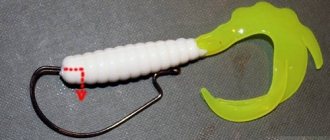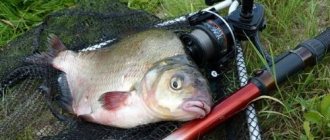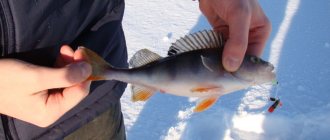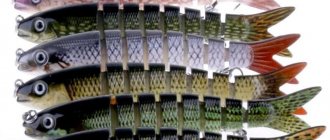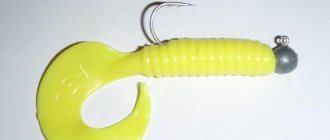Classic rigging methods.
This includes swivel mounting and mounting on a jig head. These are simple types of equipment that are accessible to everyone.
For installation you will need:
Any type of hook;
“Cheburashka” type cargo;
Bait.
Or a bait and a jig head on which a hook is already mounted.
The peculiarity of this method is that at the end of the leash there is a twist or carabiner. This allows the use of both a jig head and a hinged rig, in which the weight and hook are connected. This method allows you to change the weight and shape of the load, and due to the articulated joint, the bait becomes more mobile, providing an interesting game that is attractive to the fish.
How to attach a double to a vibrotail
6 minutes Author: Konstantin Pavlov 2
As practice shows, if there are no problems with putting a soft bait on a single hook, then not every angler knows how to put a double on a vibrotail. In this article we will answer the question: how to properly attach a vibrating tail to a hook without special equipment.
Let’s say right away that the presence of a double or triple hook significantly reduces the likelihood of fish escapes and increases the likelihood of a productive hooking. But in bodies of water whose bottom is littered with debris, there is a high probability of getting into a dead grip with a double hook with silicone. Therefore, it is worth using double hooks only in more or less cleared areas of water bodies.
It is certain that the range and equipment offered by modern fishing stores are rich in all kinds of decoys and ready-made silicone baits. You can purchase it and “don’t have to worry” anymore (about installing a double). But what to do when a predator cuts off the bait’s tail and thereby completely deprives it of the opportunity to play? It is much more profitable to supply and replace silicone on site, right on the shore or in the boat.
Vibrating tails, as a type of bait, appeared on European markets in the early 70s, when they approached the well-known twisters in popularity. With the advent of vibrating tails, fishermen choosing silicone were divided into two groups: those who preferred twisters and those who preferred baits. Bait only partially solves the problem of attachment. Gradually, the controversy subsided, and vibrating tails took their rightful place in the arsenal of any spinning player. This happened because they have a lot of advantages that set them apart from the multitude of constantly replenished “rubber”.
One of the most significant advantages is the amazing similarity to real fish. And the similarity does not end with external properties, because with its behavior the vibrotail is capable of waking even well-fed fish from a state of rest. Another advantage is its unique softness - thanks to it, the fish can peck over and over again until it gets pricked. The vibrotail bears a striking resemblance to the predator's natural food. Below we will talk about how to equip a vibrotail with a double for catching predatory fish.
Equipment for large silicone baits size XXL.
In cases where you plan to hunt a large predator, it is worth trying a larger bait to be sure to cut off the smaller specimens. In general, there is no difference between how to attach an XXL size silicone bait and a standard one. Except that for larger sizes a second “tee” is used. Using an additional leash or a piece of cord, you can add a hook to the structure. One of them is placed in the body of the bait closer to the tail. This allows you to increase the reliability of the fastening, which reduces the number of slips and empty bites, but at the same time leaves the bait mobile.
Advantages and disadvantages of doubles
The double hook, when used with edible silicone, provides a number of advantages compared to other installation options. Positive features include:
[THERE IS AN ANSWER] How to attach an offset hook to a silicone bait?
Among the disadvantages are:
- Greater likelihood of snagging compared to single hooks of a regular shape, and even more so offset ones.
- Without additional instructions, it is not clear to a novice fisherman how to put silicone on a double, so many beginners do not use them.
- Such a hook damages the silicone more, which negatively affects the service life of the bait.
Do not leave hooks stored inside edible silicone. The fact is that most of these baits contain salt, which, together with water, can severely damage the hook, especially during long-term storage. And rust will not add attractiveness to edible food.
Below are step-by-step photos, which can greatly facilitate understanding the mechanics in the absence of a more experienced friend nearby.
So, first of all, we select a double for the bait. If it is less than one third of the body length of the bait, then with sluggish activity of the fish, you cannot avoid idle bites, i.e. such moments when the fish grabs the bait, bypassing the hook.
Having picked up the hook, you need to visually mark the place where the rubber is punctured; to do this, we attach the double to the body and mark the place where the double ends.
Then we pierce the bait right through with one sting, exactly in the center of the previously marked distance
After this, it is advisable to wet the silicone in order to injure the bait less and drag the rubber to the connecting ring, pulling the hooks in different directions. This is what we should get -
Next, we wet the double and begin to push it with the connecting ring to the nose of the bait, so that the double passes through the center of the bait. (You can pierce the bait with an awl in advance exactly in the center, along the entire body, this will make it easier to thread the double and serve as a guide path for it.)
We attach the bait until the fastening ring appears. Next, slightly spreading the hooks to the sides, we adjust the rubber and mount the double on the Cheburashka. This is how it should work out for you.
If suddenly, when installing the vibrating tail, it turns out that the hooks are pointing down, simply pull out the double in the reverse order and start installation from another hook.
Next, using the double’s ear, having previously unclenched it with your fingers so as not to injure the rubber, we move it towards the head of the bait (7-8).
Spinning rod parameters
All fishing rods are conventionally divided into several categories, which are compiled depending on their nature, including action. For a beginner jig spinner, blanks with fast or super-fast action are perfect, which will allow you to perform high-quality and reliable hooking. In addition, such inventions react more sensitively to bites, which increases the chances of performing an accurate strike at the most opportune moment.
Read the report on fishing for burbot in December
When choosing a reliable fishing rod for fishing with a jig head for pike, perch or pike perch, pay attention to the test load indicators. They indicate the maximum weight of the bait that can be used on a specific form with the ability to control the wiring
Currently, there are three groups of fishing rods that differ in test characteristics:
- In the first group there are models for ultralight fishing, the test of which reaches 10 grams. It is advisable to buy them when catching small predators, such as perch or pike perch.
- The second group contains forms with a test load from 10 to 30 grams. With their help, you can comfortably catch larger prey, the weight of which reaches 10 kilograms. As a rule, it is these spinning rods that are used by domestic fishermen, as they are suitable for our natural conditions.
- The third group included models with test values from 30 grams. They are especially effective for deep-sea fishing and casting jig baits for pike into remote areas of the reservoir. If you are going to fish on a river with intense currents, then this option is the most suitable.
When choosing a good spinning blank, take into account the material of manufacture. It is advisable to choose good models from trusted manufacturers, which are created on the basis of modern materials with high strength and, most importantly, low weight. However, such fishing tools are not cheap, so a beginner may find them difficult to access.
Features of installing vibrating tails on a double
To properly equip a vibrotail with a double, you must initially select a hook with a shank length comparable to the length of the bait’s body before it begins to narrow to the tail. A fish strung on the fore-end should not lose the mobility of its working element, that is, the tail. Having pierced the body of the silicone using one of the methods described above, the fastening ring of the accessory is released in the center of the muzzle of the bait, and the tip of the hooks is placed as close as possible to the back of the bait, practically placing the tip on the body of the bait.
Important! The stings of the hooks on vibrotails are visually located not in the center of the fish, but closer to its rear.
Properly installed silicone should sit firmly on the rod, without the possibility of scrolling or sliding, and also symmetrically with respect to its longitudinal axis. The asymmetry of the location of the nozzle will negatively affect the quality of the wiring performed, leading to the silicone falling to one side during pauses.
Installation features
Since their invention, vibrotails have undergone significant changes. Thus, the mobility of the tail was increased, and the bait itself acquired a more elongated body. You can purchase ready-made doubles equipped with vibrating tails (equipment from the kit).
It should be noted that often when biting, the predator cuts or bites off the back of the bait. In this case, the game comes to naught; you need to change the bait. There will be no problems with a single hook, let’s look at how to put on a “double” correctly.
One of the most important features when fishing with a vibrotail is its equipment. Just like a twister, it can be put on a single hook (equipped with a jig head), or a “eared” sinker with a single, double or triple hook attached to it. The second option is more acceptable, and here we will look at why:
- Firstly, it is difficult to choose a jig head that would match the parameters of a vibrotail. It usually turns out that the head suitable for the size of the sinker is equipped with a hook of such a size that when hooked, it literally paralyzes the bait and there is no question of any game. Or a suitable hook has a head that does not load enough bait;
- Secondly, the eared load allows you to change its size in a short time, using only winding rings;
- Thirdly, the eared load allows you to make longer casts.
In our opinion, any spinning player should have a set of vibrating tails in their arsenal. We pay special attention to how a bait equipped with an eared sinker behaves in water. Anglers have become accustomed to the fact that the bait with the jig head is facing upside down. With an eared sinker in the water, it turns at a right angle, so the bait goes sideways, as it were.
Features of installation of vibrating tails
After selecting a hook of suitable length, you must:
- Attach the double to the bait so that the eye of the hook looks out of it in the finished installation.
- Mark with your finger on the bait the place from which the hook will come out.
Photo 1. We attach the double to the bait.
Photo 2. We pierce at the marked point.
Photo 3. Pull the hook until the ring comes out.
A simpler method is also possible. Equipping a vibrotail with a double can be done literally in one movement, although this option is not suitable for all baits. Having figured out where the hook should come out of the vibrating tail, you just need to pierce its body with the eye of the double until it comes out from the front.
Photo 4. Top view.
Photo 5. We connect it to the load through a ring.
